Deciding on the right evergreen bonsai tree species can be an overwhelming endeavor, especially with the vast array of options available to both novice and seasoned bonsai growers. Whether you’re just starting out or looking to challenge your skills with more demanding species, understanding the specific characteristics and care requirements of each type is essential.
Evergreen bonsai trees, cherished for their year-round foliage and resilience, are a popular choice among enthusiasts. These trees maintain their verdant leaves throughout the seasons, subtly replacing old growth without a noticeable leaf-fall period. This constant greenery provides a continuous display of beauty and tranquility, making evergreens particularly appealing.
In this comprehensive guide, we will delve into the unique qualities of various evergreen bonsai species—from the low-maintenance and beginner-friendly types to those that pose a rewarding challenge for intermediate growers. Whether you prefer a tree that thrives indoors or one that stands out in an outdoor setting, this article will help you navigate your options and make informed decisions to enhance your bonsai journey.
Read on to discover the key pros and cons of each species, understand their specific environmental needs, and learn how to select the perfect tree that aligns with your bonsai aspirations and growing conditions.
17 Best Evergreen Bonsai Tree Species for Beginners
There are numerous evergreen tree species from different parts of the world that are suitable for beginner bonsai growers.
To narrow down your choices, let’s briefly discuss each one of them:
1. Juniper

| Botanical name: | Juniperus |
| Tree type: | Coniferous evergreen |
| Native habitat: | Mountains throughout Southwest Asia, Europe, and North America |
| Placement: | Outdoors only |
| Species to get: | Green Mound juniper (Juniperus procumbens nana), Chinese juniper (Juniperus chinensis), Japanese Shimpaku (Juniperus sargentii), Japanese needle juniper (Juniperus rigida), Savin juniper (Juniperus sabina), Common juniper (Juniperus communis), California juniper (Juniperus californica), Rocky Mountain Juniper (Juniperus scopulorum), and Sierra juniper (Juniperus occidentalis). |
| Cost range: | $15 to $3500 |
Juniper is one of the best-recommended tree species for beginners. It’s not only low maintenance but also easy to shape as a classic bonsai.
It has a slender trunk with live brown veins and silvery deadwood, which significantly adds aesthetic appeal to it.
On top of that, it has fine needle pads that form attractive foliage.
Pros:
- Drought-tolerant
- Requires minimal winter protection
- Branches can be bent aggressively
- Withstands aggressive pruning very well
Cons:
- Can’t be kept indoors
- Bare tree parts can’t produce new buds
2. Ficus
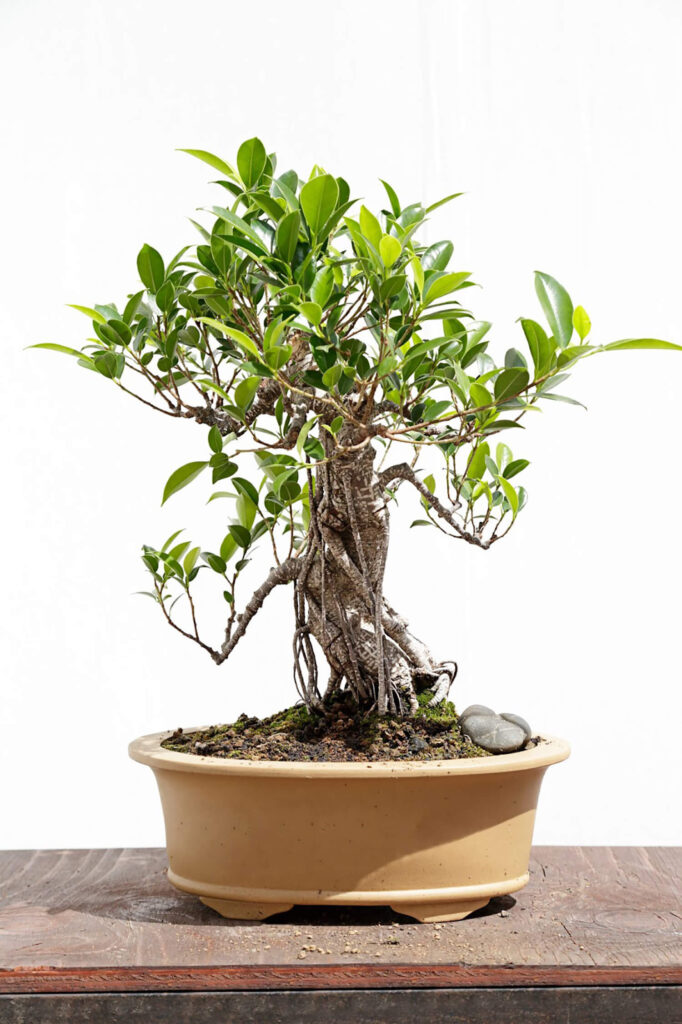
| Botanical name: | Ficus |
| Other names: | Fig tree |
| Tree type: | Broadleaf evergreen |
| Native habitat: | Tropic regions around the globe |
| Placement: | Thrives indoors |
| Varieties to get: | Ginseng ficus (Ficus retusa), Weeping fig (Ficus benjamina), Chinese Banyan (Ficus microcarpa), and Sacred fig (Ficus religiosa) |
| Cost range: | $20 to $625 |
Are you looking for an indoor bonsai? Then, the ficus tree is your best option.
This tree species is popularly cultivated as an indoor bonsai since it’s resilient and endures low humidity.
It has oval-shaped, dark green, glossy, waxy leaves and a bulbous trunk that makes it appear aged. Some species also form interesting twisted surface roots, which adds drama to the tree.
Pros:
- Low maintenance
- Endures low humidity
- Very hardy, resilient, and forgiving
- Pest-resistant when cared for properly
Cons:
- Needs lots of light
- Can’t tolerate sudden changes or cold drafts
3. Azalea
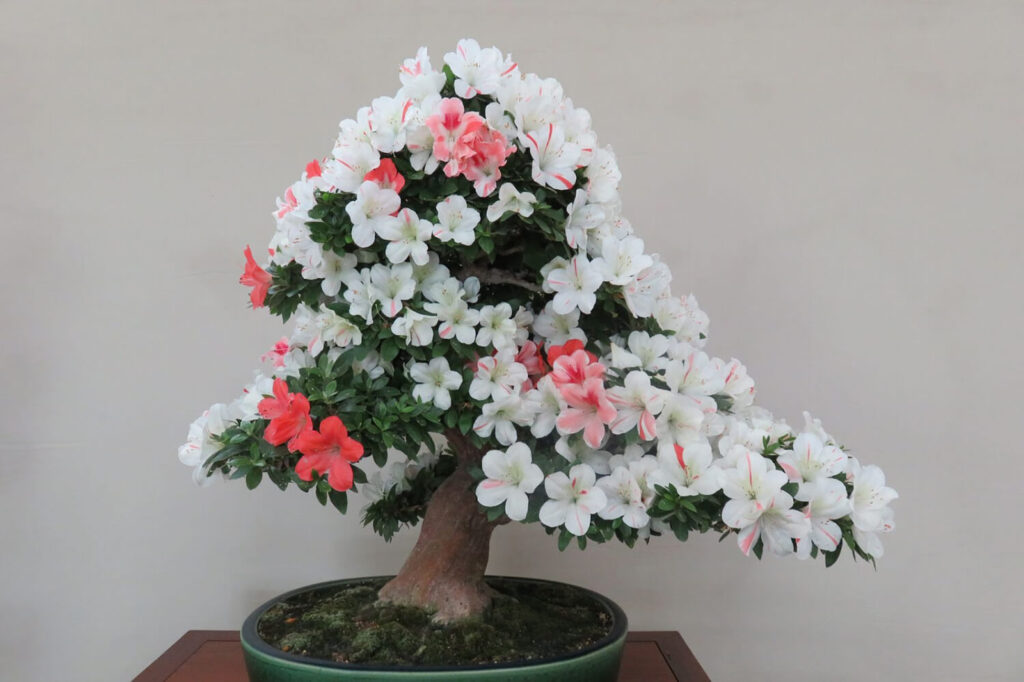
| Botanical name: | Rhododendron |
| Tree type: | Broadleaf evergreen |
| Native habitat: | Temperate regions of Asia, Europe, and North America. Also, in tropical regions of Northern Australia and Southeast Asia |
| Placement: | Can be kept indoors, but preferably outdoors |
| Species to get: | Satsuki azalea (Rhododendron indicum) and Kurume azalea (Rhododendron kiusianum & Rhododendron kaempferi |
| Cost range: | $50 to $1600 |
Azalea is probably the most popular flowering bonsai tree species. That’s because it’s hardy, resilient, and generous in producing new shoots and spectacular blossoms.
It grows striking white, pink, purple, and red flowers in late spring, which makes it stand out from the rest. These flowers are numerous and big enough to cover the tree’s entire canopy.
Pros:
- Hardy
- Non-susceptible to pests
- Withstands strong pruning
- Endures some frost when healthy
- Produces new shoots from bare areas
Cons:
- Doesn’t like hard water
- Have delicate (thin and matted) roots
4. Fukien Tea
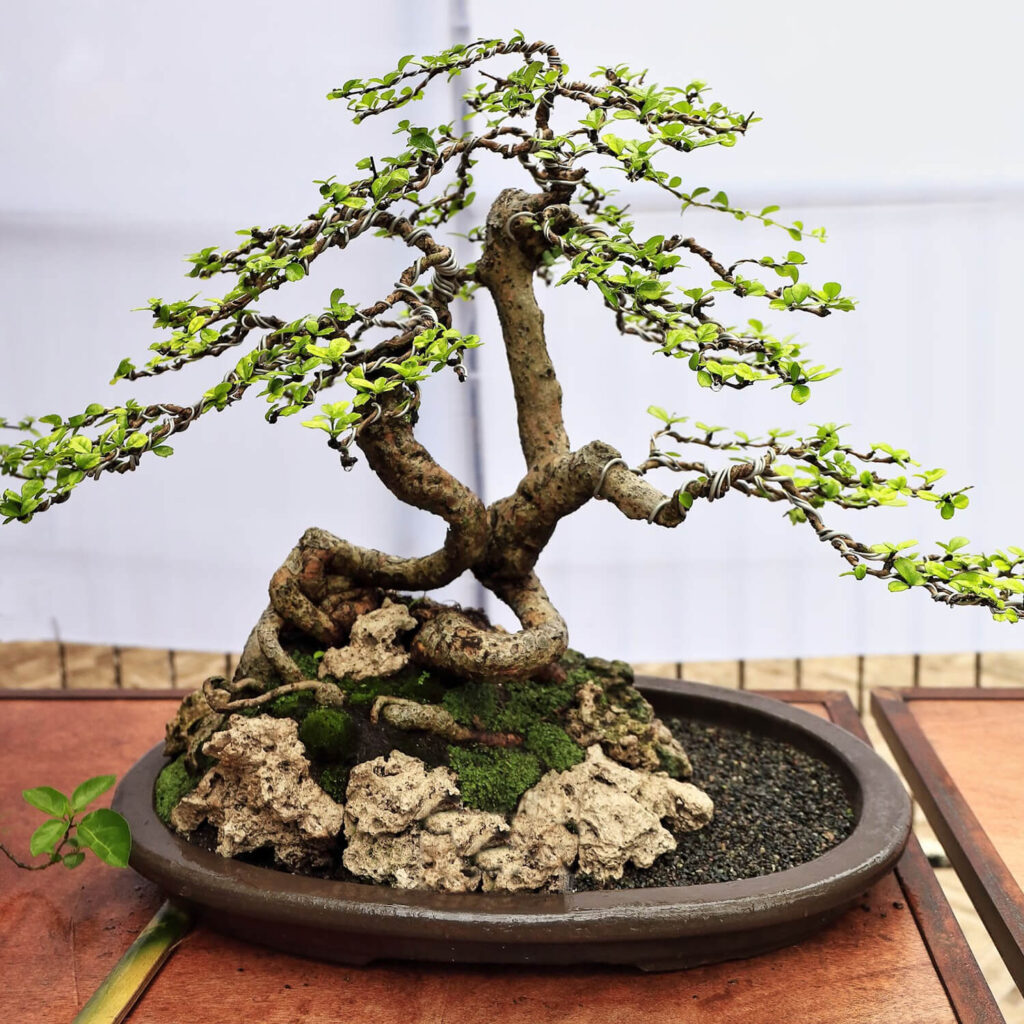
| Botanical name: | Ehretia microphylla or Carmona retusa |
| Other names: | Carmona, Philippine tea tree |
| Tree type: | Broadleaf evergreen |
| Native habitat: | East Asia and Southeast Asia |
| Placement: | Traditionally indoors, but can be placed outdoors in very warm climates |
| Cost range: | $30 to $1290 |
Fukien tea is another popular flowering bonsai tree species.
It’s known for its round leaves with white dots and fine hairs, tiny berries, and small, white flowers that bloom year-round.
If there’s one thing that makes this tree so interesting, it is its knotted trunk that adds flow and drama to the subject.
Pros:
- Tolerates pruning very well
Cons:
- Needs lots of light
- Have a sensitive root system
- Doesn’t like drought and excess wetness
5. Brazilian Rain Tree
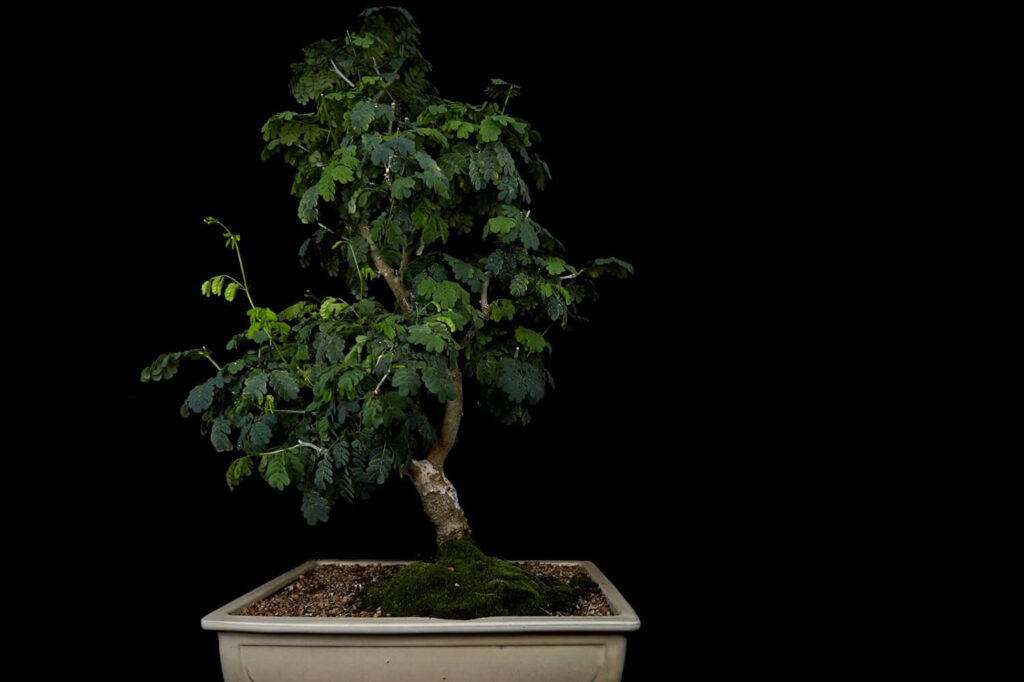
| Botanical name: | Pithecellobium tortum |
| Tree type: | Broadleaf |
| Native habitat: | Rainforests of Brazil |
| Placement: | Both indoors and outdoors |
| Cost range: | $40 to $780 |
Want a fun and interesting tree species? Then choose the Brazilian rain tree, an evergreen bonsai tree.
This hardwood tree has compound green leaves that fold up at night or once it gets dark. Then, open up again in the morning.
In spring, it produces white and pinkish, puffy flowers with a pleasant scent—so you can place it inside your house and benefit from its pleasant fragrance.
Pros:
- Very hardy
- Fast growing
- Tolerates dry conditions
- Quite resistant to pests and diseases
Cons:
- Needs lots of light
- Doesn’t tolerate frost
- Sensitive to changing environment
- Prone to die-back when pruned completely
6. Hawaiian Umbrella
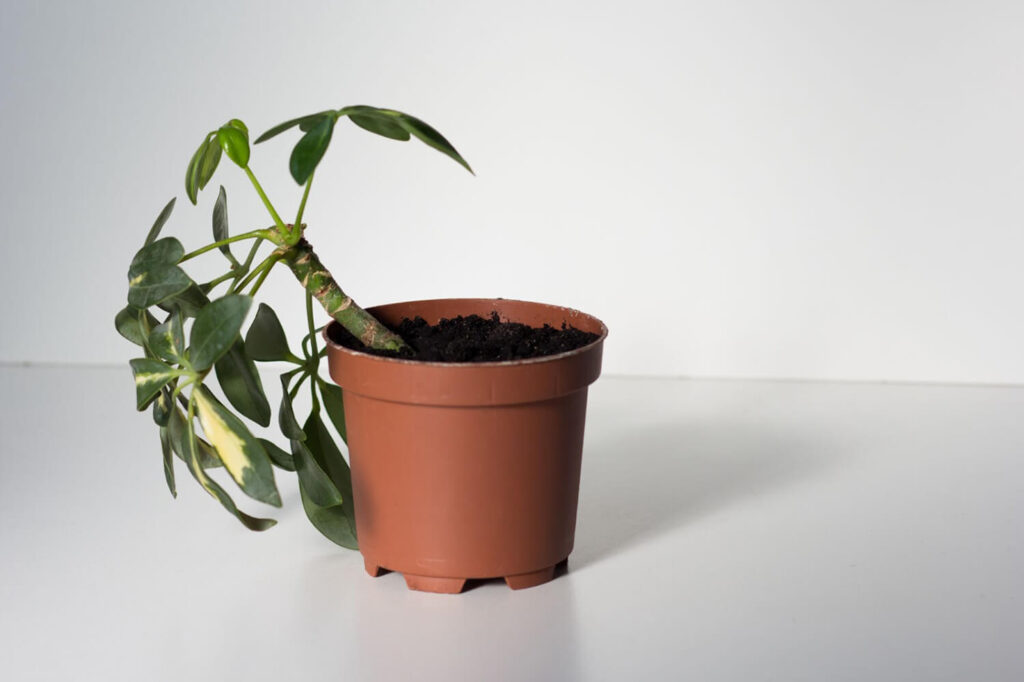
| Botanical name: | Schefflera arboricola |
| Other names: | Dwarf Umbrella |
| Tree type: | Broadleaf evergreen |
| Native habitat: | Australia and Southeast Asia |
| Placement: | Thrives indoors |
| Cost range: | $13 to $350 |
Hawaiian umbrella is a tropical tree with thin trunks and compound leaves that sit on long petioles. Due to these distinctive features, it’s often styled as a bonsai forest.
It’s named “umbrella” because its leaves are shaped like umbrellas—its leaflets are huge and tend to curve slightly downward.
Unlike other species, this tree can’t form good ramifications. However, it still makes a great bonsai piece since it forms dense-looking foliage, thanks to its large leaves.
Pros:
- Low maintenance
- Tolerates low light and humidity
- Non-susceptible to pests and diseases
Cons:
- Poisonous
- Have delicate fleshy roots
- May snap when bent too strongly
7. Buddhist Pine

| Botanical name: | Podocarpus macrophyllus |
| Other names: | Chinese Yew, Fern Pine, Yew Plum Pine |
| Tree type: | Coniferous evergreen |
| Native habitat: | Tropical mountain regions of China and Japan |
| Placement: | Thrives indoors |
| Cost range: | $13 to $275 |
Buddhist pine is a tropical tree with dark green lanceolate leaves and blue-green fruit, resembling Common Yew.
Additionally, it has a dark brown bark that turns scaly over time—giving off a classic bonsai appeal.
Its Chinese name is “luóhàn sōng,” meaning “arhat pine.” Arhat is an important figure in Buddhism, which explains the name of this species.
Pros:
- Responds to pruning very well
- Hardly susceptible to pests and diseases
Cons:
- Slow growing
- Not frost hardy
- Doesn’t like calcareous water
- Doesn’t tolerate heavy root pruning
8. Money Tree

| Botanical name: | Pachira aquatica |
| Tree type: | Broadleaf evergreen |
| Native habitat: | Central America |
| Placement: | Thrives indoors |
| Cost range: | $20 to $250 |
Money tree is a tropical species with hand-shaped compound leaves and brown to gray bark. It’s often styled with a braided trunk, which acts as its focal point.
Some healthy, older species bloom yellow-green or cream-colored, long flowers with red tips.
This tree species is also popular as a Feng Shui item since it’s believed that this tree can bring fortune and good luck to the place.
Pros:
- Responds to pruning very well
- Hardly susceptible to pests and diseases
Cons:
- Requires high humidity
- Not easy to style as a classic bonsai
9. Boxwood
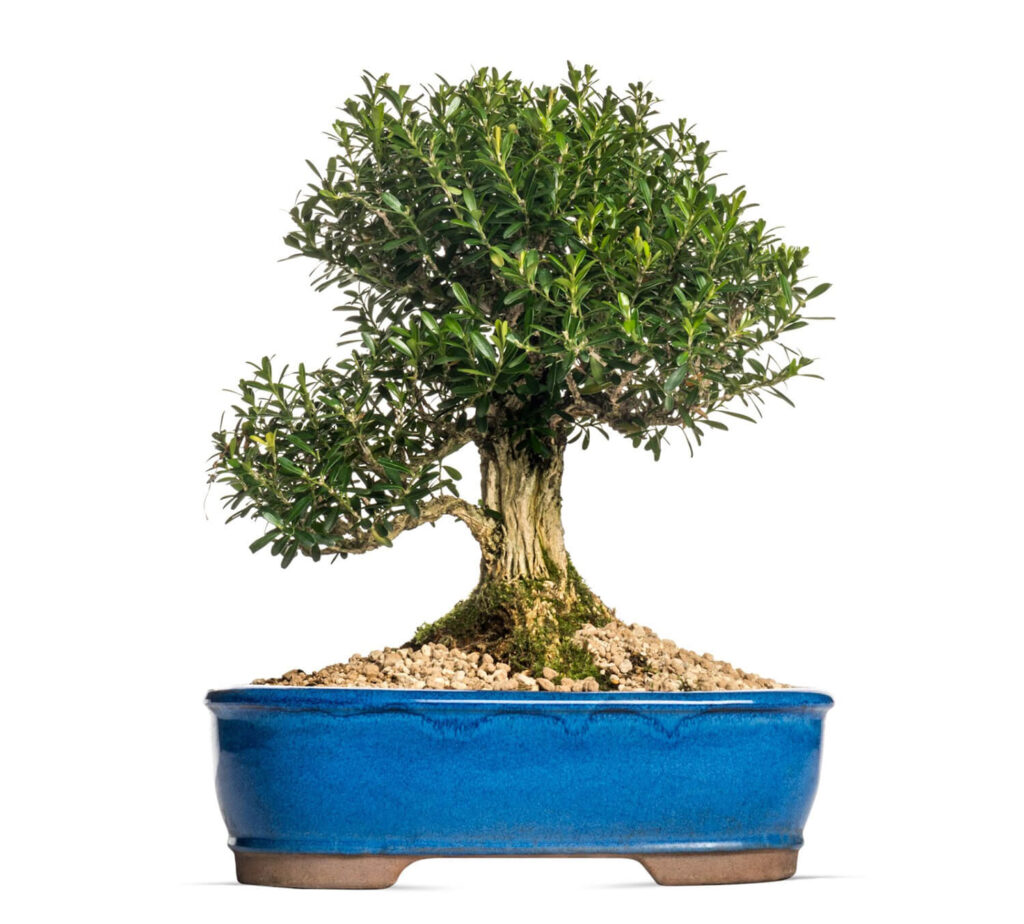
| Botanical name: | Buxus |
| Other names: | Box |
| Tree type: | Broadleaf evergreen bonsai tree |
| Native habitat: | South Europe, West Asia, and North Africa |
| Placement: | Both indoors and outdoors |
| Species to get: | European common boxwood (Buxus sempervirens) and Chinese boxwood (Buxus harlandii) |
| Cost range: | $30 to $400 |
Boxwood is highly prized for its twisted trunks and branches. These features make the tree look ragged, adding aesthetic value to the subject.
It produces yellow-green flowers that blend well with the dark green leaves—creating a dense-looking canopy.
On top of all that, it has strong, fibrous roots that can form a strong and good nebari.
Pros:
- Very robust
- Fast growing
- Tolerates hard pruning
- Withstands short dry periods
- Tolerates extensive deadwood sculpturing
Cons:
- Have delicate bark
- All parts are poisonous
- Susceptible to fungal diseases
You might also be interested in: Where to buy bonsai trees?
10. Firethorn
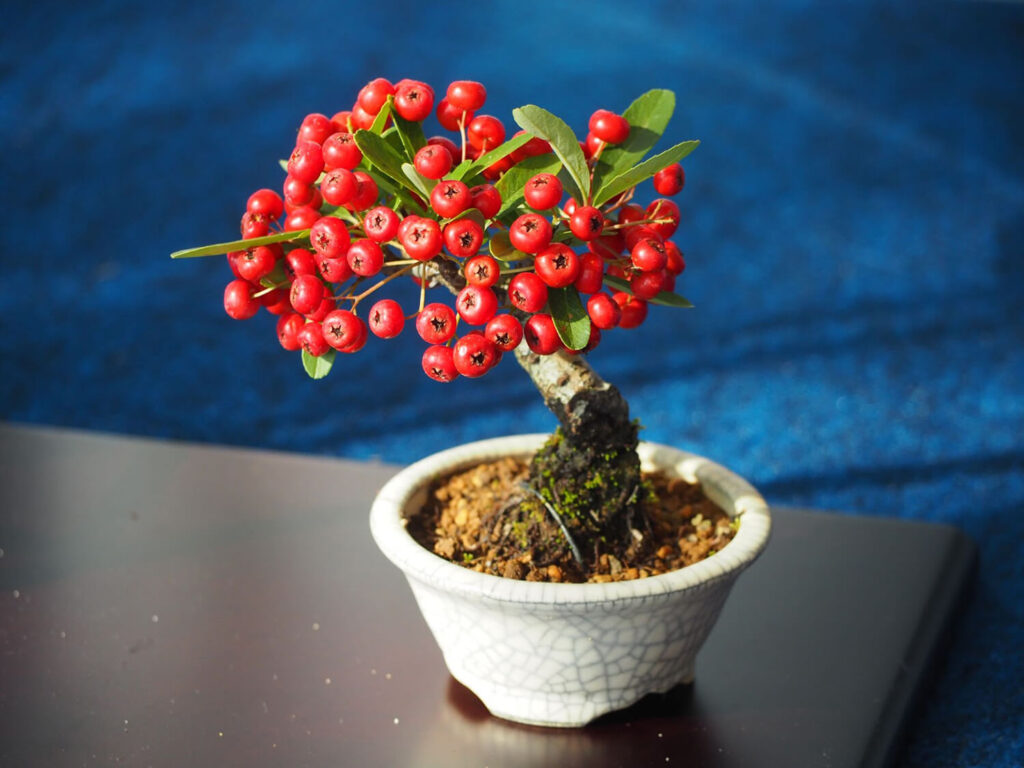
| Botanical name: | Pyracantha |
| Tree type: | Broadleaf evergreen |
| Native habitat: | Sparse forest of China and Southern Europe |
| Placement: | Both indoors and outdoors |
| Species to get: | Narrowleaf firethorn (Pyracantha angustifolia) and Scarlet firethorn (Pyracantha coccinea) |
| Cost range: | $14 to $12500 |
If you want an eye-striking bonsai tree, grow a firethorn specimen.
This species produces small, red berries from late summer to winter. Apart from that, it also grows small, fragrant, white clustered flowers in spring. Thus, you can expect a gorgeous-looking bonsai tree year-round.
The only downside is that it has strong, sharp thorns on the twigs, so wear protective gloves when working with it.
Pros:
- Frost-hardy
- Tolerates hard pruning
- Grows buds from old wood quickly
Cons:
- Thorny
- Older branches are stiff and brittle
- Susceptible to pests and diseases
- Needs plenty of water to produce fruits
- Fruits, seeds, and leaves are slightly poisonous to humans
11. Privet
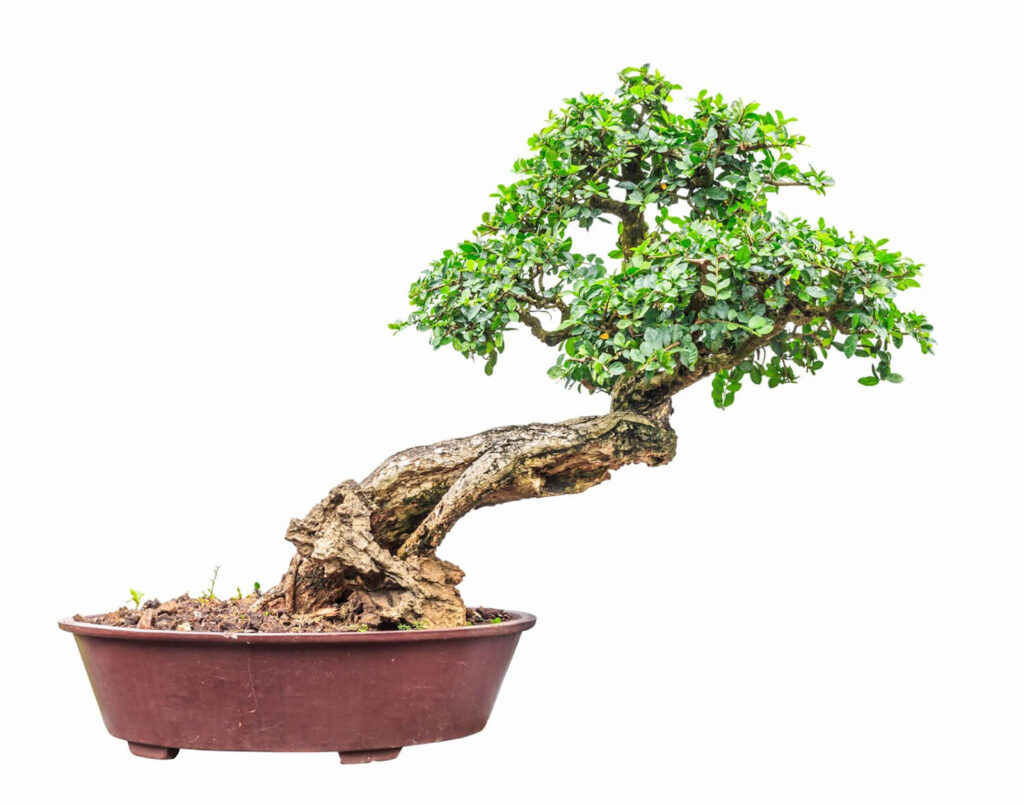
| Botanical name: | Ligustrum |
| Tree type: | Broadleaf evergreen |
| Native habitat: | Asia, North Africa, Europe |
| Placement: | Preferable outdoors, but Chinese privet can thrive indoors |
| Species to get: | Chinese privet (Ligustrum sinensis), Japanese privet (Ligustrum japonicum), Common privet (Ligustrum vulgaris), Oval-leafed privet (Ligustrum ovalifolium), and Shiny-leaved privet (Ligustrum lucidum) |
| Cost range: | $26 to $440 |
Another flowering tree option is privet.
This tree species has oval-shaped, green leaves that can form a dense canopy. That being said, if you want to achieve a “full” look, privet can be a great option.
In summer, it grows small, fragrant, white flowers. Then, it produces small, black berries in the fall. However, these berries are moderately poisonous, so make sure not to consume them.
Pros:
- Robust
- Fast growing
- Grows in any soil
- Responds to pruning very well
Cons:
- Have soft, delicate bark
- Sensitive to very calcareous water
- Produces moderately poisonous black fruit
- Can be attacked by whiteflies, aphids, and scale
12. Olive
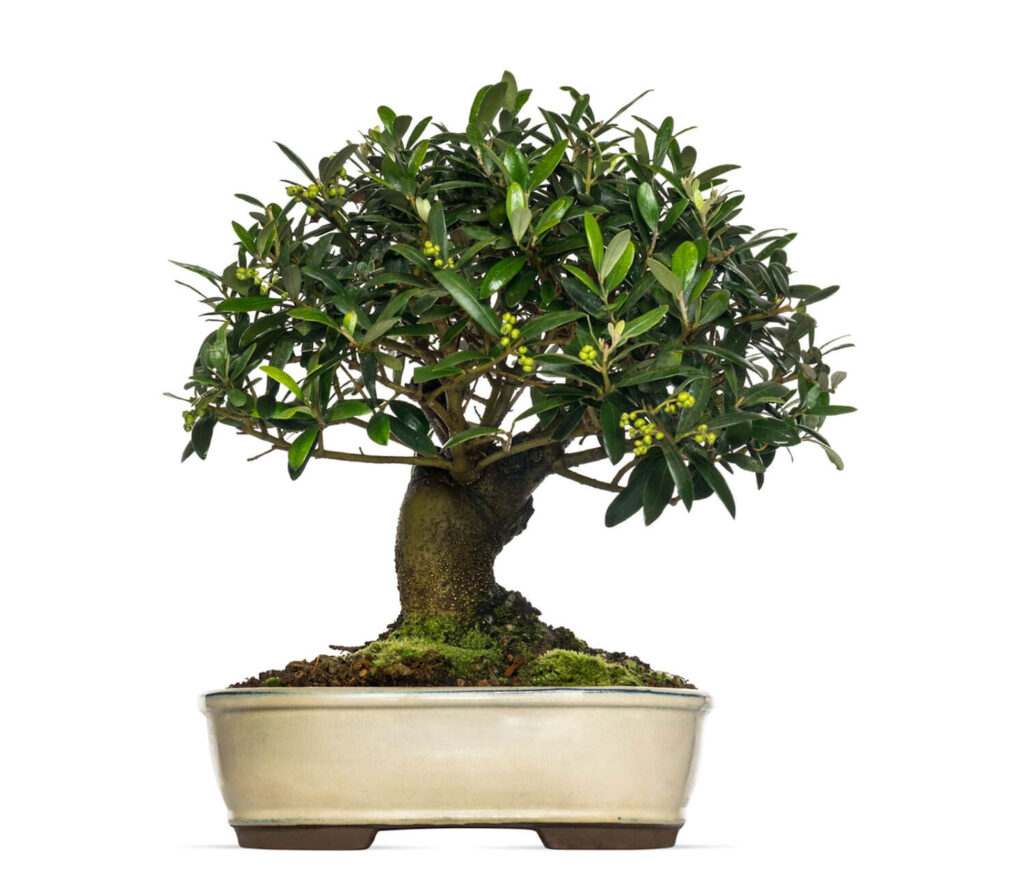
| Botanical name: | Olea europaea |
| Tree type: | Broadleaf evergreen |
| Native habitat: | Mediterranean countries |
| Placement: | Both indoors and outdoors |
| Varieties to get: | Wild olive (Olea sylvestris & Olea oleaster) |
| Cost range: | $35 to $495 |
While it’s more commonly cultivated for its fruit, olive trees can be grown as bonsai too.
This tree species has very tiny leaves and short internodes, which can help form a dense canopy.
It also produces small, yellowish clustered flowers in spring. Then, the drupes appear shortly after that. These small edible drupes turn from green to black, usually starting in the summer until mid-winter.
Pros:
- Reaches a very old age
- Forms impressive trunks
- Produces buds from old wood
Cons:
- Slow growing
- Old branches are stiff and brittle
- Susceptible to scale when poorly cared for
13. Spruce

| Botanical name: | Picea |
| Tree type: | Coniferous evergreen |
| Native habitat: | Temperate and cold regions of Northern hemisphere |
| Placement: | Preferably outdoors |
| Species to get: | Ezo spruce (Picea jezoensis), Norway spruce (Picea abies), Colorado blue spruce (Picea pungens), and Black spruce (Picea mariana) |
| Cost range: | $35 to $550 |
Spruce has a classic conical shape, which is common to conifer trees.
If you look at it from a distance, it has a similar silhouette to juniper or pine bonsai. The only difference is that spruce has four-sided needles and whorled branches.
Its cones hang downwards, and its branches tend to bend downwards as well, with their tips slightly pointing upwards.
Pros:
- Propagates easily
- Have flexible branches
Cons:
- Doesn’t grow buds on old wood
- Prone to various pests and diseases
- Not easy to style as a classic bonsai
- Old trees don’t tolerate heavy root pruning
14. Cotoneaster
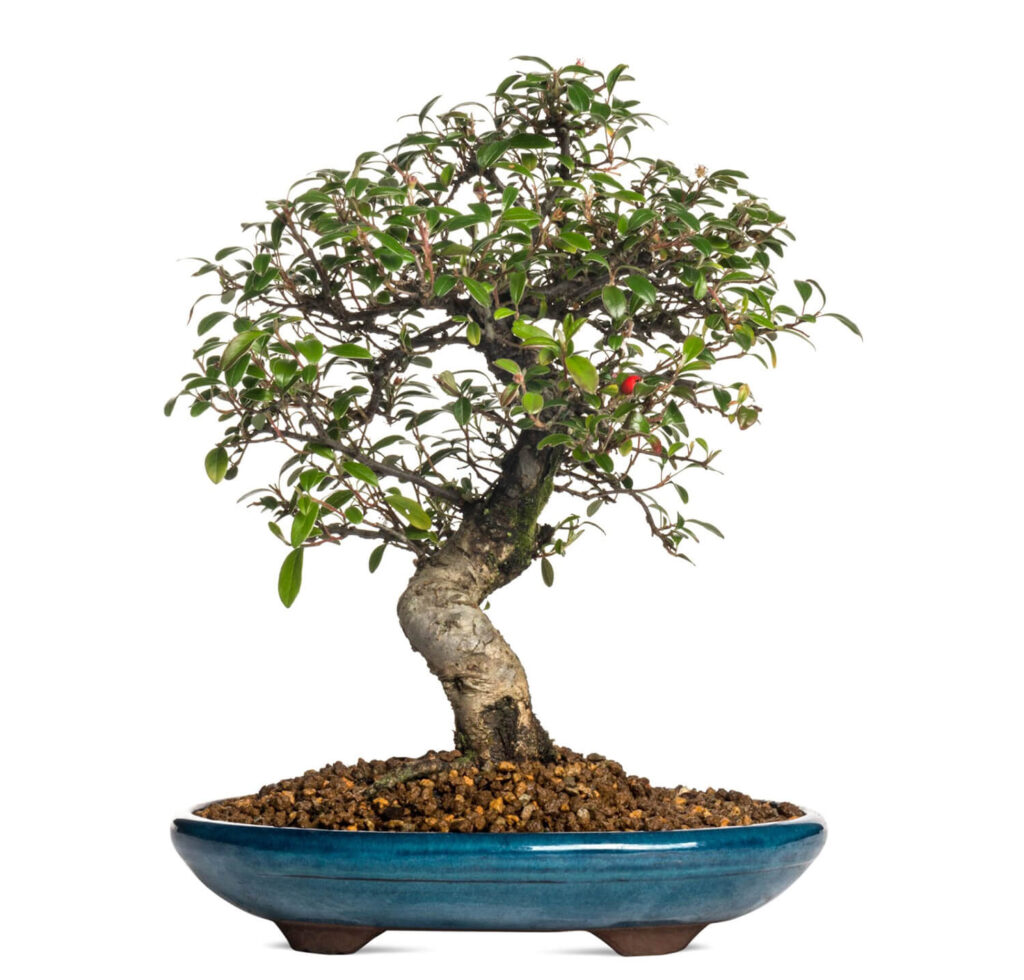
| Botanical name: | Cotoneaster |
| Tree type: | Broadleaf evergreen |
| Native habitat: | Asia, Europe, and North Africa |
| Placement: | Outdoors |
| Species to get: | Rock cotoneaster (Cotoneaster horizontalis), Little Leaf cotoneaster (Cotoneaster microphyllus), and Hedge cotoneaster (Cotoneaster lucidus) |
| Cost range: | $23 to $119 |
If you’re looking for another easy-to-care fruit-bearing tree species, try the cotoneaster.
This one produces small, red fruits during autumn. Its small, dark green, glossy leaves also change color to yellow, orange, or red in the same season.
Then, in spring, it grows tiny, white flowers that make the tree look very appealing.
Additionally, some of its species develop a wide nebari that also adds great aesthetic value to the tree.
Pros:
- Frost hardy
- Grows in diverse soils
- Withstands short droughts
- Young trees have flexible branches
- Tolerates constant pruning very well
Cons:
- Older trees have stiff branches
- Prone to various pests and diseases
15. Silverberry
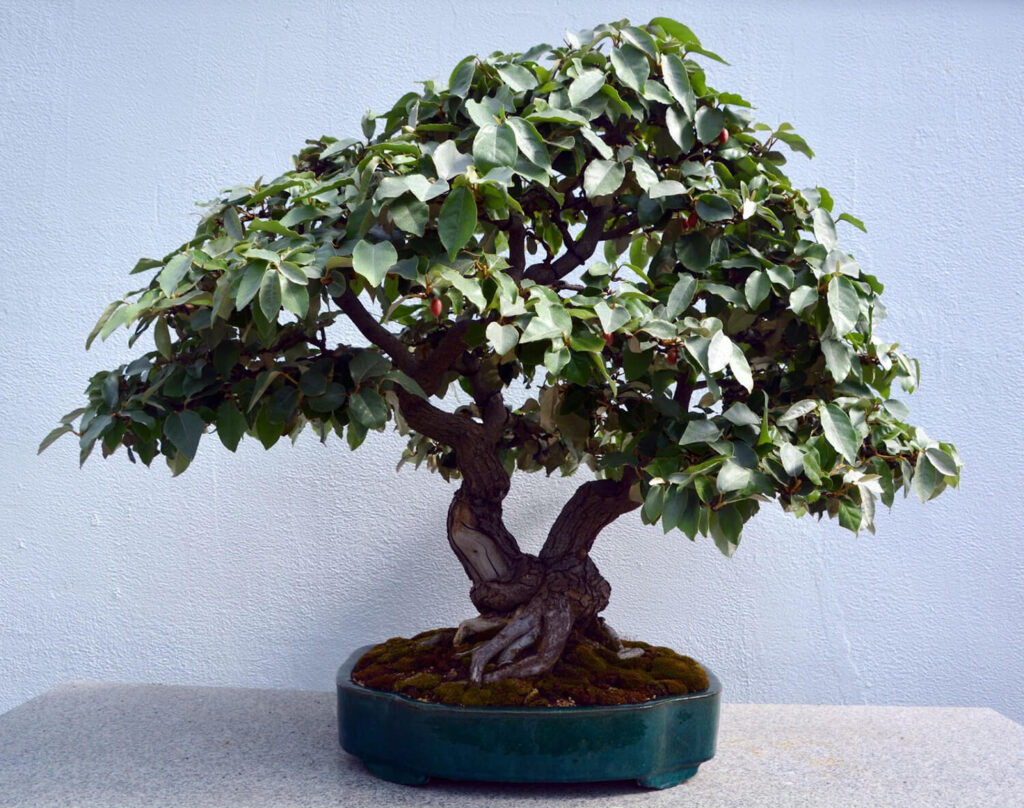
| Botanical name: | Elaeagnus pungens |
| Other names: | Com Goumi, Goumi Berry |
| Tree type: | Broadleaf evergreen |
| Native habitat: | Asia (mostly Japan and China) |
| Placement: | Thrives outdoors |
| Cost range: | $45 to $850 |
This tree produces silvery berries; hence it’s called silverberry.
Unlike other evergreen bonsai trees, its oval-shaped green leaves have silvery undersides. These leaves also have a unique texture and somewhat rough feel to them.
Silverberry also blooms white flowers in spring, making it a great decorative piece.
Since this tree species naturally grows tall and upright, it’s best suited as a large bonsai.
Pros:
- Hardy foliage
- Can be trained easily
- Withstands many climates
- Responds to defoliation very well
Cons:
- Requires some winter protection
16. Japanese Holly

| Botanical name: | Ilex crenata |
| Tree type: | Broadleaf evergreen |
| Native habitat: | East China, Japan, Taiwan, and Korea |
| Placement: | Thrives outdoors |
| Cost range: | $36 to $355 |
Japanese holly is a flowering and fruit-bearing tree.
In late spring, it produces tiny, white flowers. Then, not long after that, it bears pea-sized, shiny, black fruits.
Due to its tiny green leaves and silhouette, it’s sometimes confused for boxwood.
To differentiate the two, look closely at their flowers and leaves. The Japanese holly flower has rounded petals, and its leaves are arranged in an alternate pattern.
Pros:
- Frost-hardy
- Responds to pruning very well
Cons:
- Bark gets scared easily
- Branches are quite brittle
- Susceptible to vine weevil, spider mites, and leaf-miner moths
17. Tamarind
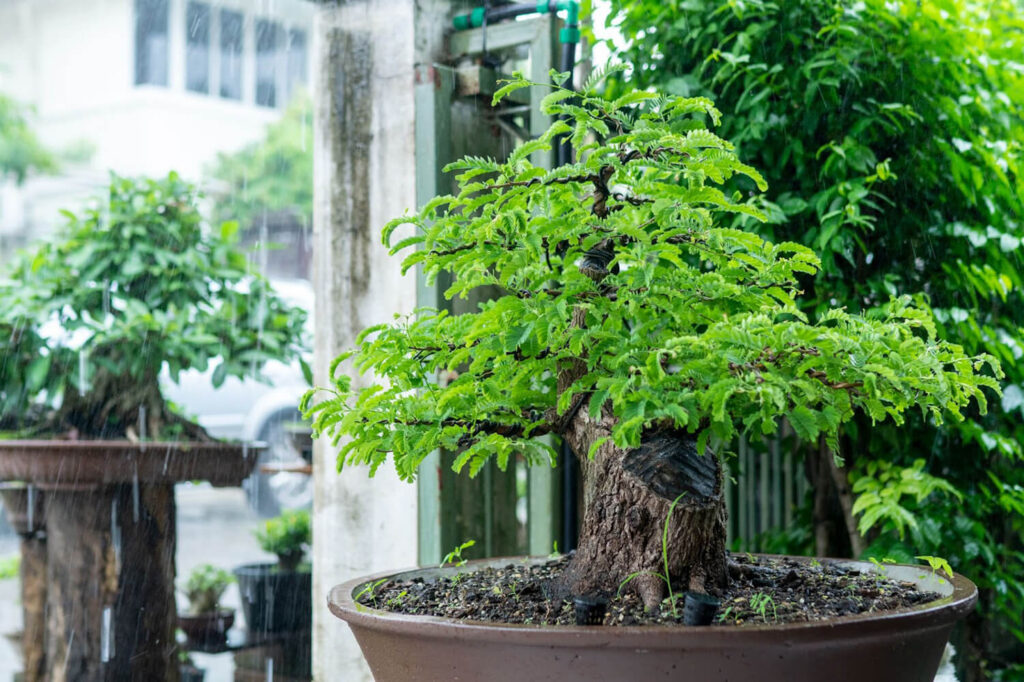
| Botanical name: | Tamarindus indica |
| Tree type: | Broadleaf evergreen |
| Native habitat: | Africa and other tropic regions |
| Placement: | Thrives indoors |
| Cost range: | $25 to $195 |
If you want something that’s also useful in the kitchen, grow a tamarind bonsai.
This tree species produces brown edible pods called “tamarind.” These pods are popularly used as a tangy seasoning for various dishes and soups.
In spring, it blooms small, fragrant, orchid-looking flowers. They first appear as tiny pink buds. Then, they open up to reveal longer, cream-colored petals with orange or red streaks. As soon as these flowers fully bloom, they fall off the shoots.
Pros:
- Forgiving
- Very sturdy
- Tolerates heavy pruning
- Grows in diverse climatic conditions
Cons:
- Slow growing
14 Best Evergreen Bonsai Tree Species for Advanced Growers
While growing easy-to-care-for tree species is the safest option…
Selecting challenging ones will help you enhance your horticulture knowledge and master several bonsai techniques.
To help you choose, let’s discuss the best types of bonsai evergreen trees suitable for advanced growers:
1. Japanese Black and Red Pine
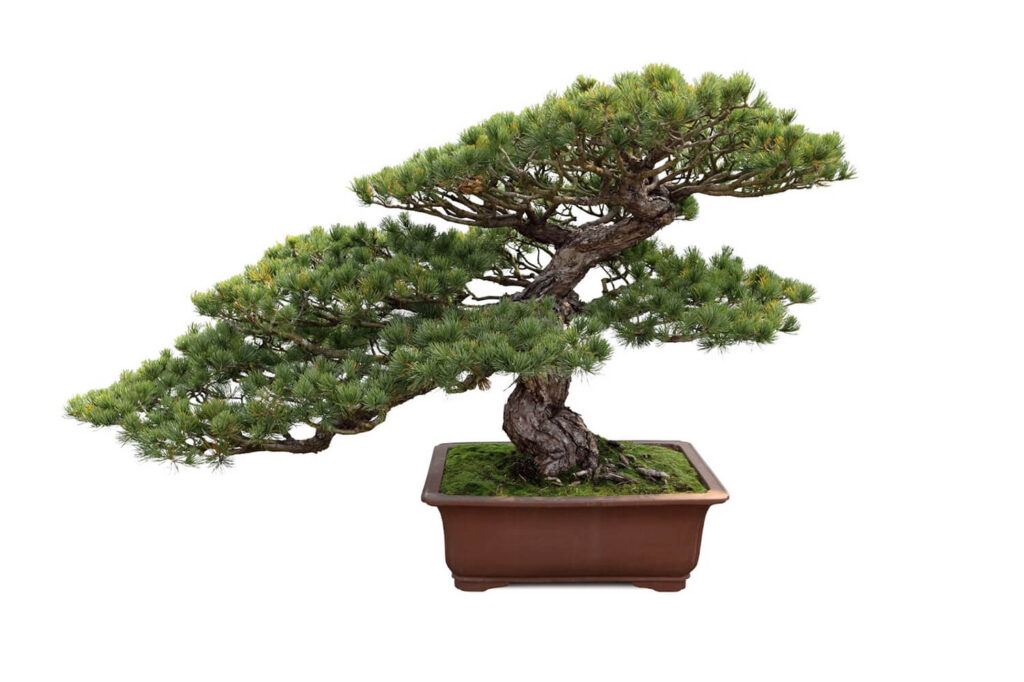
| Botanical name: | Pinus |
| Tree type: | Coniferous evergreen |
| Native habitat: | Coastlines throughout Japan |
| Placement: | Thrives outdoors |
| Species to get: | Japanese black pine (Pinus thunbergii) and Japanese red pine (Pinus densiflora) |
| Cost range: | $33 to $4500 |
Japanese black and red pines are two of the most popular evergreen bonsai types. They’re highly prized for their extreme taper and thick trunks.
Both of these species are two-needle pines. The only difference between them is that the Japanese black pine has strong and hard needles, while the Japanese red pine has delicate and softer pairs.
Japanese black pines are often styled with a nearly perfect triangular shape. On the other hand, Japanese red pines often appear tall and slender.
The good thing about these types of evergreen bonsai trees is that they produce a flush of growth twice a year, so pruning these trees wouldn’t cause any issues.
Pros:
- Very hardy
- Withstands harsh climates
- Red pines tolerate a bit lower temperature
Cons:
- Requires winter protection
- Doesn’t like permanent moisture
- Susceptible to scale, aphids, spider mites, and caterpillars
2. Japanese White Pine
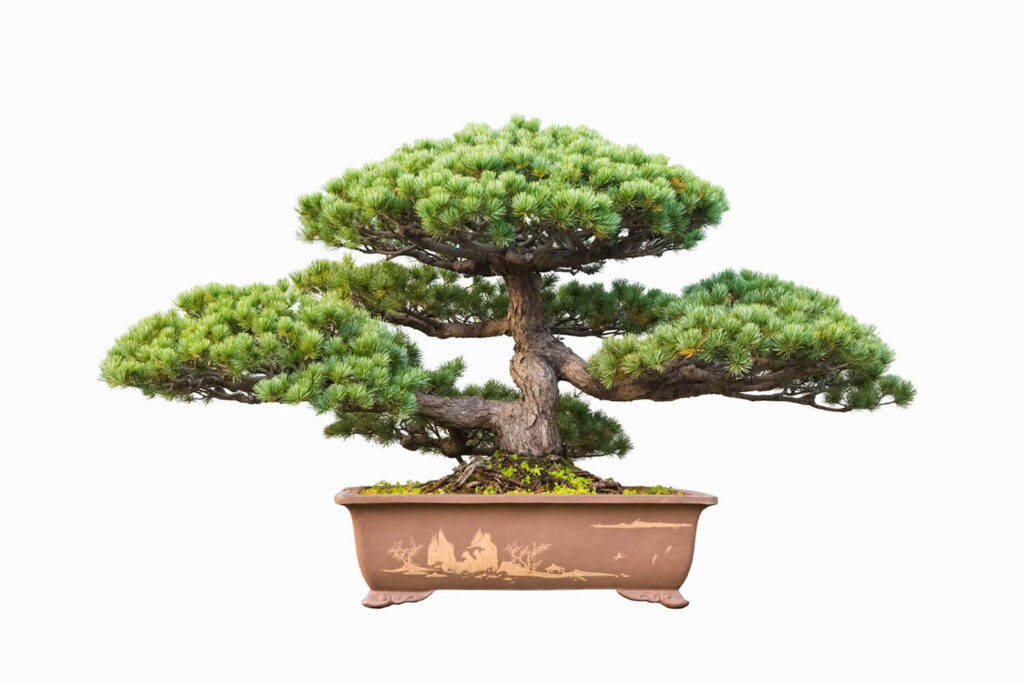
| Botanical name: | Pinus parviflora |
| Other names: | Five-needle pine |
| Tree type: | Coniferous evergreen |
| Native habitat: | High mountain regions of Japan |
| Placement: | Outdoors only |
| Varieties to get: | Kokonie, Zuisho, and Myojo |
| Cost range: | $50 to $1295 |
Unlike the ones mentioned above, the Japanese white pine is a five-needle pine.
If you’d look closely at its needle, you’d notice that the top part is blue-green, and the bottom part is somewhat blueish. Also, they’re soft and fragrant—that’s why the Japanese white pine is often described as a feminine pine species.
In contrast to its delicate needles, its bark is grayish and scaly, which makes it appear old and rough.
While you can grow one from a “pure” material, it’s often grafted on Japanese black pine to promote more stable growth.
Pros:
- Very hardy
- Creates striking landscape
- Grows in diverse soil conditions
Cons:
- Have delicate bark
- Needs winter protection
- Susceptible to pests, diseases, and root rot
3. Hinoki Cypress
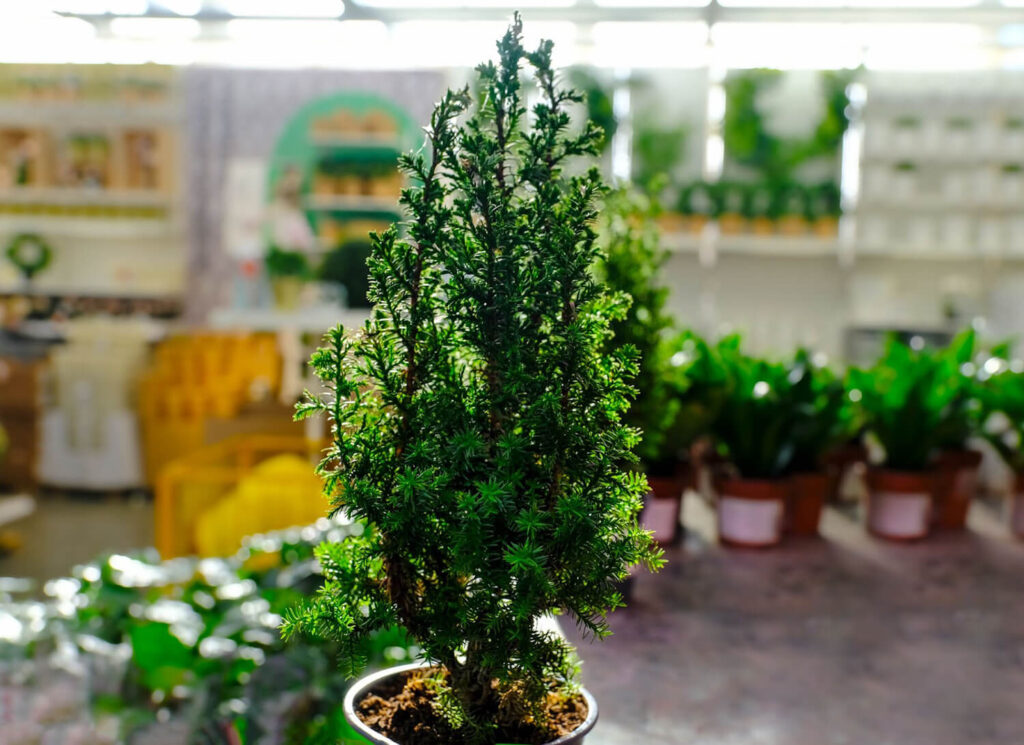
| Botanical name: | Chamaecyparis obtusa |
| Tree type: | Coniferous evergreen |
| Native habitat: | Low elevation mountains of Japan and Taiwan |
| Placement: | Outdoors only |
| Varieties to get: | Chirimen, Sekka, and Yatsubusa |
| Cost range: | $22 to $525 |
Hinoki cypress is another tree species capable of forming a dense canopy. However, this tree requires extra maintenance, so beginners may find it quite hard to care for.
It has scale-like, dark green leaves and reddish-brown, scaly bark. These particular features make the tree appear ragged, which is what a good bonsai should look like.
Unlike the other coniferous trees, the cones of hinoki cypress are rather spherical and contain winged seeds.
Pros:
- Fast growing
- Can be propagated in various ways
Cons:
- Doesn’t like limewater
- Needs winter protection
- Requires frequent pruning
- Needs high humidity and lots of light
- Susceptible to spider mites and scale
4. Brush Cherry

| Botanical name: | Syzygium or Eugenia myrtifolia |
| Tree type: | Broadleaf evergreen |
| Native habitat: | New Zealand and Australia |
| Placement: | Both indoors and outdoors |
| Cost range: | $30 to $190 |
As one of the popular evergreen bonsai types, Brush cherry has lance-shaped, dark green, glossy leaves that resemble those of boxwood. These leaves are firm and arranged in opposite leaf patterns.
In spring, it grows small, puffy white flowers that can cover the entire foliage.
It also produces small, red edible fruits in autumn, which are mildly sour and can be eaten fresh or cooked.
Pros:
- Grows vigorously
- Tolerates below 32°F (0°C) temperature
Cons:
- Branches scar easily
- Have to be pruned often
- Susceptible to various pests
- Large cut wounds don’t heal well
- Doesn’t tolerate frost and inconsistent temperature
5. Snow Rose
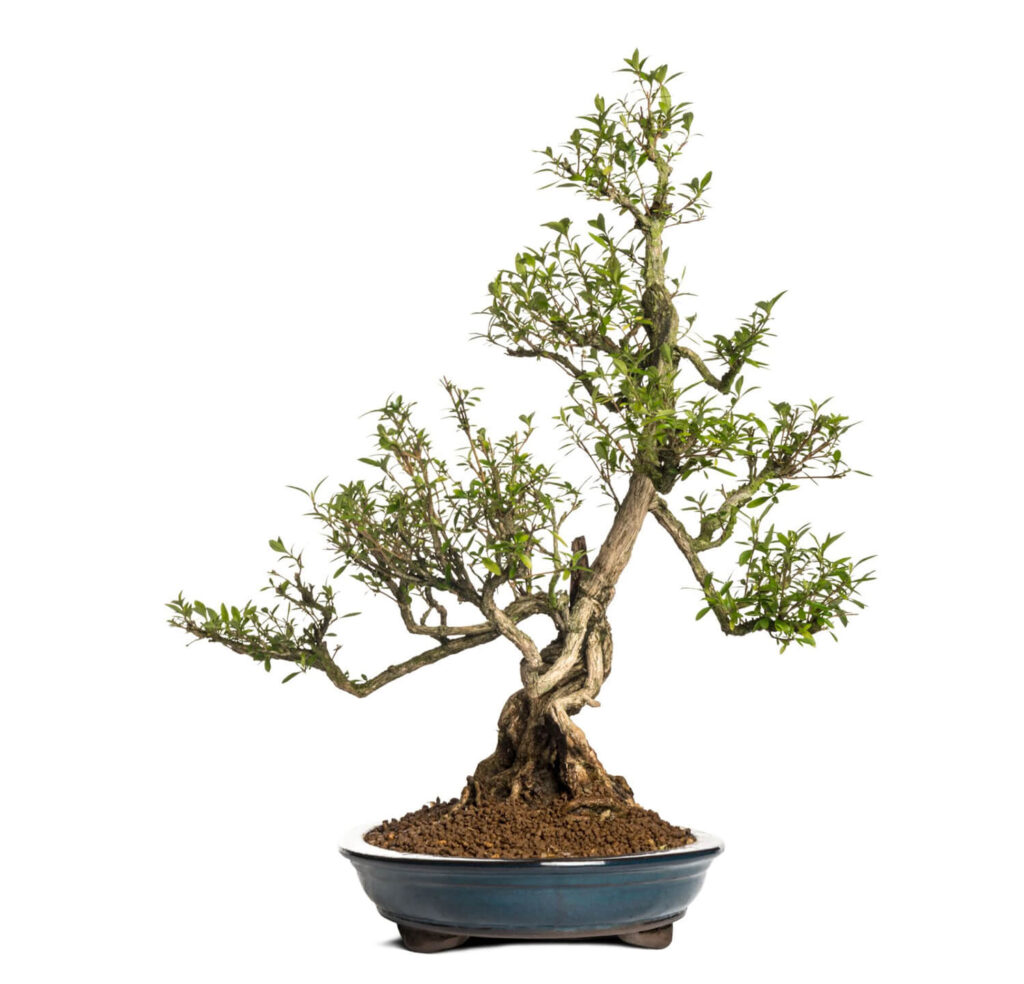
| Botanical name: | Serissa japonica or Serissa foetida |
| Other names: | Serissa, Japanese boxthorn, Tree of thousand stars |
| Tree type: | Broadleaf evergreen |
| Native habitat: | Subtropical regions of China, Japan, and South Asia |
| Placement: | Preferably outdoors, but can be kept indoors |
| Cost range: | $18 to $152 |
Snow rose is a small subtropical shrub growing on damp forest edges. It has tiny, oval-shaped, green, glossy leaves.
From spring through summer, it produces lovely, small, white flowers. Depending on the condition of the specimen, it can bloom twice or thrice per year.
Furthermore, snow rose makes a great bonsai material due to its rough, gray bark and ability to form fine ramifications.
Pros:
- Grows vigorously
- Tolerates hard pruning
- Produces fine ramification
Cons:
- Branches are delicate
- Doesn’t like calcareous water
- Prefers lots of light and high humidity
- Susceptible to pests and prone to root rot
- Roots and foliage smell unpleasant when cut
- Doesn’t tolerate drastic temperature drops and frost
6. Acacia
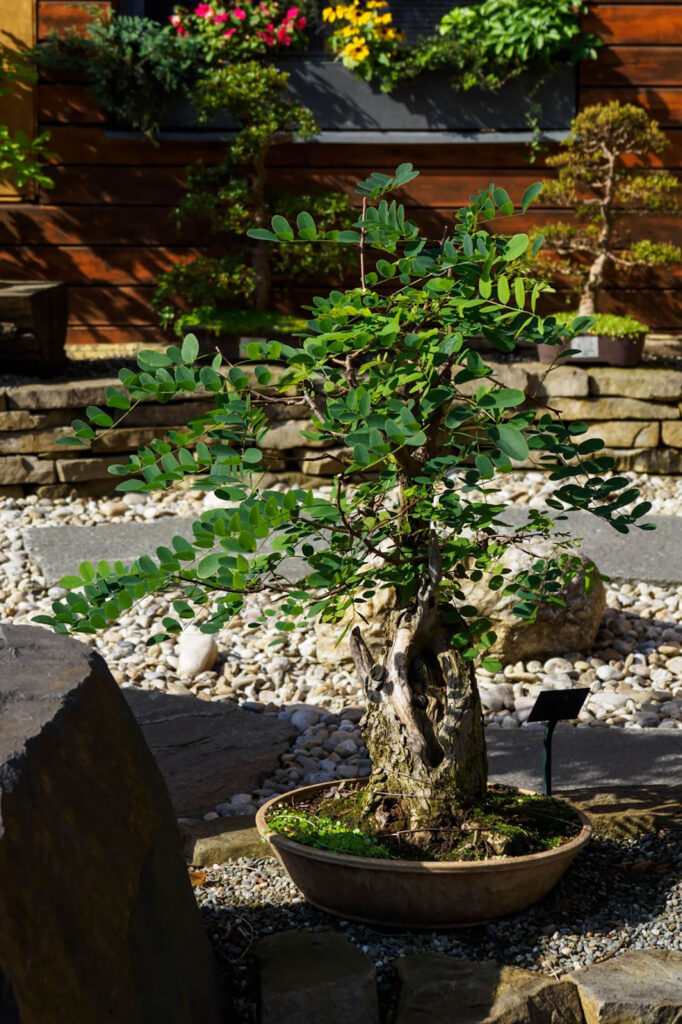
| Botanical name: | Acacia |
| Other names: | Wattle |
| Tree type: | Broadleaf evergreen |
| Native habitat: | Tropical and subtropical regions of Australia, Africa, and Central America |
| Placement: | Thrives indoors |
| Cost range: | $25 to $315 |
Most acacia trees have pinnate green leaves. However, some species have phyllodes in replacement of the typical leaves—these are modified leaf stems that function the same.
This species grows small, fragrant flowers that look like pom poms. Depending on the species, it can appear white, yellow, or pink. Since these flowers produce lots of pollen, they sometimes attract bees during the flowering season.
Additionally, it produces long, narrow seed pods cultivated for various purposes.
Some of its species also have sharp thorns on their trunks and branches, so you’d have to be careful when working with them.
Pros:
- Fast growing
- Produces fine ramification
- Young trees have flexible branches
- Non-susceptible to pests and diseases
Cons:
- Not frost-tolerant
- Needs lots of light
- Thorny (select species)
- Requires frequent trimming
- Doesn’t like calcareous water
- Doesn’t tolerate heavy root pruning
7. Musk Maple
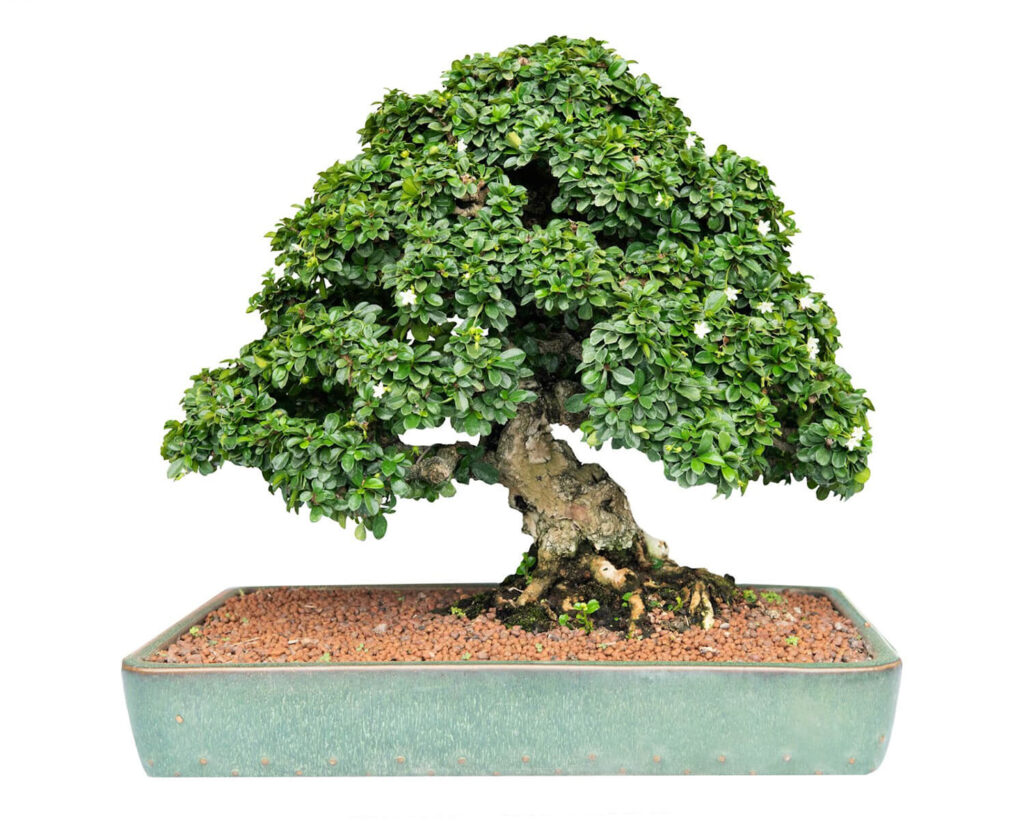
| Botanical name: | Premna |
| Tree type: | Broadleaf evergreen (except with Japanese premna, which is deciduous) |
| Native habitat: | Southeast Asia, Africa, and North Australia |
| Placement: | Both indoors and outdoors |
| Species to get: | Japanese premna (Premna japonica), Premna obtusifolia, Premna serratifolia, and Premna microphylla |
| Cost range: | $25 to $600 |
Musk maple, also called premna, is a tropical and subtropical tree popularly cultivated as a shohin size bonsai and is one of the evergreen bonsai types.
Depending on the species, it can have either ovate or toothed leaves. These leaves are arranged in opposite patterns and produce an unpleasant smell when pinched.
It grows small, yellowish flowers in summer. Then, shortly after that, it produces small black fruits.
More than anything, musk maple is valued for its light beige bark, textured trunk, and fine ramification.
Pros:
- Grows vigorously
- Strong root growth
- Endures slight frost
- Quite resistant to pests
- Young trees are flexible
Cons:
- Needs lots of light
- Doesn’t like very calcareous water
- Leaves have an unpleasant smell when crushed
8. Bird Plum
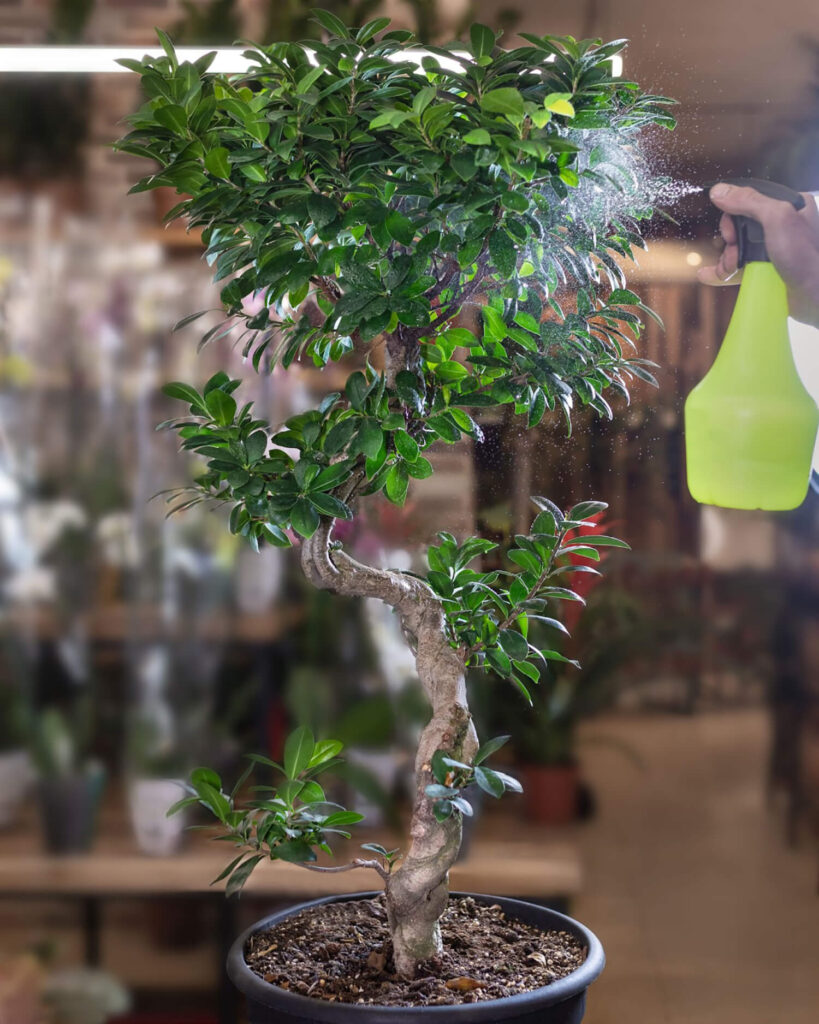
| Botanical name: | Sageretia theezans |
| Other names: | Chinese sweet plum |
| Tree type: | Broadleaf evergreen |
| Native habitat: | China and Japan |
| Placement: | Thrives indoors |
| Cost range: | $25 to $165 |
Bird plum is a subtropical tree with small, oval-shaped, light green, glossy leaves.
It produces yellowish flower panicles and small, plum-shaped edible fruits in the late summer.
One of its best features is its dark brown bark with light brown patches. This particular feature makes the tree look ragged and old, even if it’s still young.
Pros:
- Produces fine ramification
- Responds to pruning very well
- Can be propagated from softwood and hardwood cuttings
Cons:
- Not frost-tolerant
- Needs high humidity
- Old trees have brittle branches
- Sensitive to insufficient watering
- Doesn’t like very calcareous water
- Susceptible to white flies and aphids
9. Pittosporum
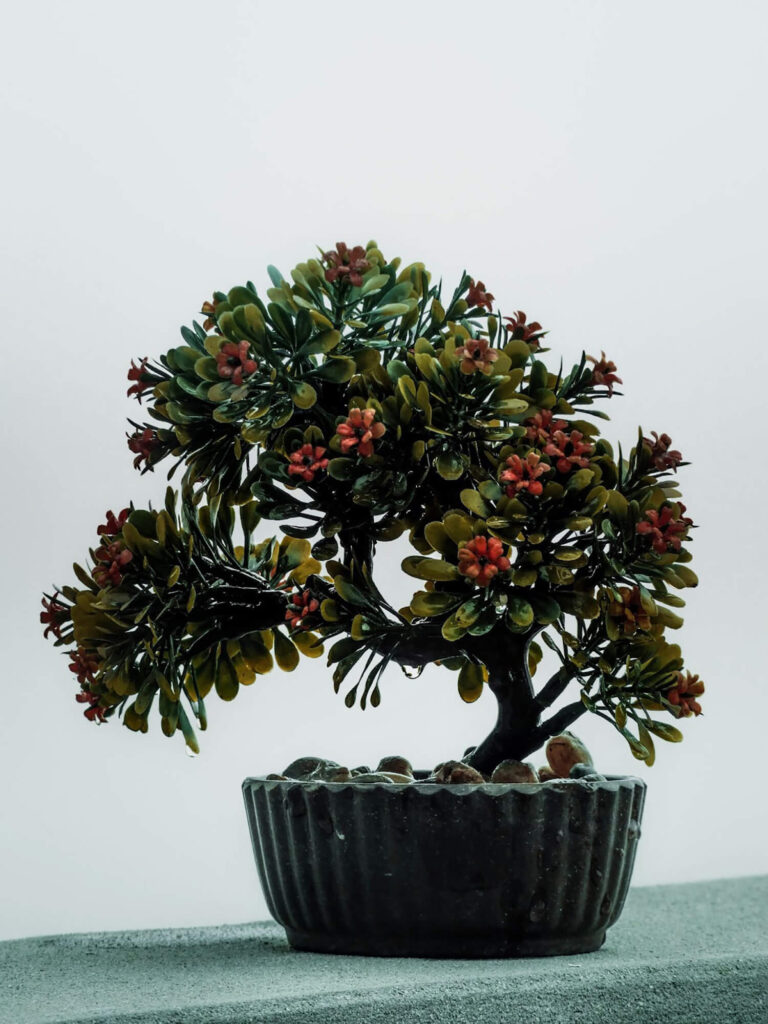
| Botanical name: | Pittosporum |
| Other names: | Japanese pittosporum, Japanese mock orange, Japanese cheesewood, Australian laurel |
| Tree type: | Broadleaf evergreen |
| Native habitat: | Japan, China, and Korea |
| Placement: | Both indoors and outdoors |
| Species to get: | Pittosporum viridiflorum, Pittosporum tobira, and Pittosporum tobira variegatum |
| Cost range: | $21 to $341 |
Pittosporum blooms tiny, cream-colored flowers in spring. These flowers have a sweet fragrance similar to orange blossoms; hence it’s called a “mock orange.”
This shrub species has stiff branches and thick, dark green, glossy leaves.
Additionally, mature specimens bear small capsules with a leathery and hairy texture. Once they ripen, they open up and reveal several black seeds.
Pros:
- Quite drought-tolerant
- Very hardy and durable
- Quite tolerant of strong winds
- Responds to heavy pruning very well
Cons:
- Susceptible to pests and diseases
- Doesn’t tolerate heavy root pruning
You might also like: Where can I find bonsai trees for sale?
10. Hemlock
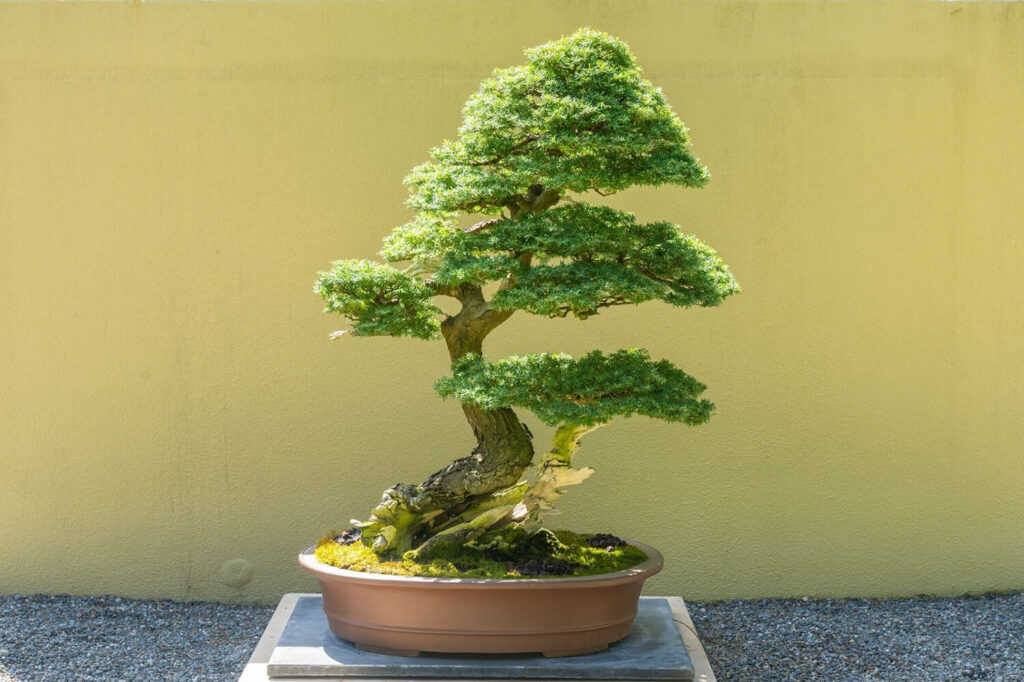
| Botanical name: | Tsuga |
| Tree type: | Coniferous evergreen |
| Native habitat: | Temperate zones of East Asia and North America |
| Placement: | Thrives outdoors |
| Species to get: | Mountain hemlock (Tsuga mertensiana), Japanese hemlock (Tsuga diversifolia), Canadian hemlock (Tsuga canadensis), and West American hemlock (Tsuga heterophylla) |
| Cost range: | $35 to $225 |
Hemlock trees have elegant-looking silhouettes, but they are quite rare—so finding a hemlock bonsai material can be difficult.
It has a classic conical shape and gray-brown bark that’s scaly and deeply furrowed. It also has overhanging branches that add interest and drama to the tree.
Mature specimens also produce small, globular, brown cones that hang on the branches. Some of these cones remain attached to the tree even after they ripen.
Pros:
- Frost-tolerant
- Produces compact ramification
- Responds to normal root pruning well
- Non-susceptible to pests and diseases
Cons:
- Slow growing
- Doesn’t like very calcareous water
11. Bougainvillea
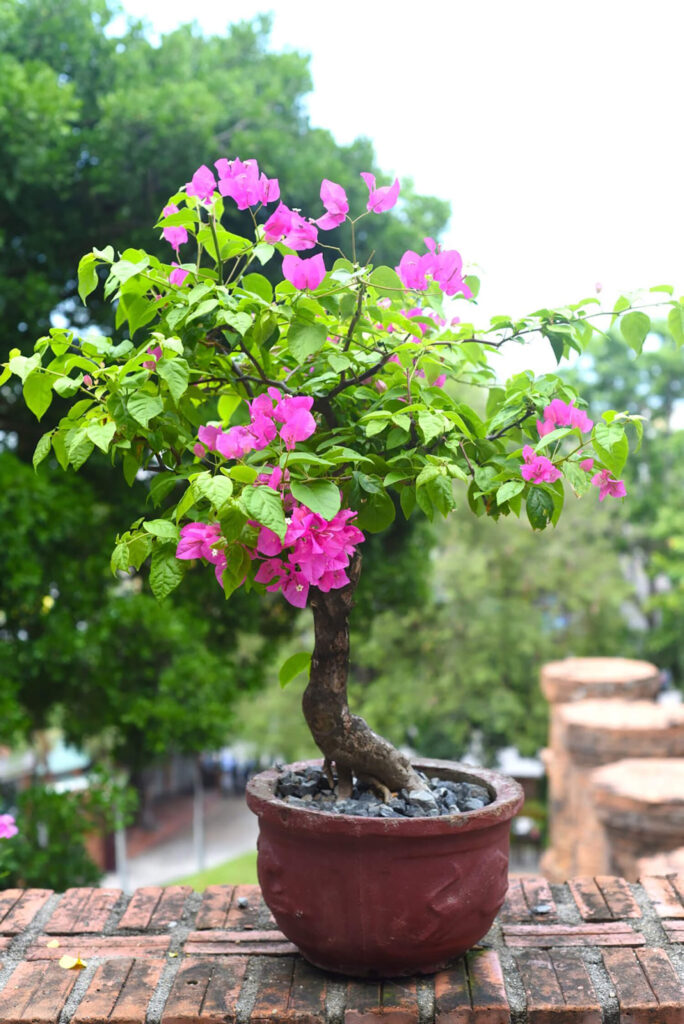
| Botanical name: | Bougainvillea |
| Tree type: | Broadleaf evergreen |
| Native habitat: | South America |
| Placement: | Outdoors only |
| Cost range: | $16 to $1890 |
Bougainvillea, a subtropical species and one of the evergreen bonsai types, is often planted in parks and gardens.
More than anything, it’s popular for its bright, papery flowers that show up from summer to spring. These trumpet-shaped blossoms appear in yellow, magenta, or purple color, depending on the species.
A bougainvillea bonsai tree is hard not to notice as its colorful flowers cover the entire foliage, making the tree stand out from the rest.
Along with that, it’s known for its beige-gray bark that gets rough and furrowed over time.
Pros:
- Fast growing
- Ensures frost
- Non-susceptible to pests and diseases
- Can be easily styled as a classic bonsai
Cons:
- Thorny
- Old branches are stiff
- Roots are thin and delicate
- Large cut wounds heal slow
- Needs lots of light and warmth
- Doesn’t like highly calcareous water
12. Fuchsia

| Botanical name: | Fuchsia |
| Tree type: | Broadleaf evergreen |
| Native habitat: | Tropical and subtropical regions of New Zealand, Tahiti, and Central & South America |
| Placement: | Thieves outdoors |
| Species to get: | Small-leaved fuchsia (Fuchsia microphylla), Hummingbird fuchsia (Fuchsia magellanica), Brilliant fuchsia (Fuchsia fulgens), and Thyme-leaved fuchsia (Fuchsia minimiflora) |
| Cost range: | $30 to $145 |
Fuchsia has one of the most interesting flowers ever.
Unlike the other flowering bonsai tree species, fuchsia flowers are shaped like teardrops—the flowers hang and point downwards. Depending on the species, these blossoms appear pinkish or purplish in the summer.
Although its trunk is quite thin compared to others, it can be bent to create an interesting trunk form. Some artists style it slanted or semi-cascade.
Pros:
- Hardy
- Fast growing
Cons:
- Susceptible to aphids
- Requires high humidity
- Have to be pruned regularly
13. Hibiscus
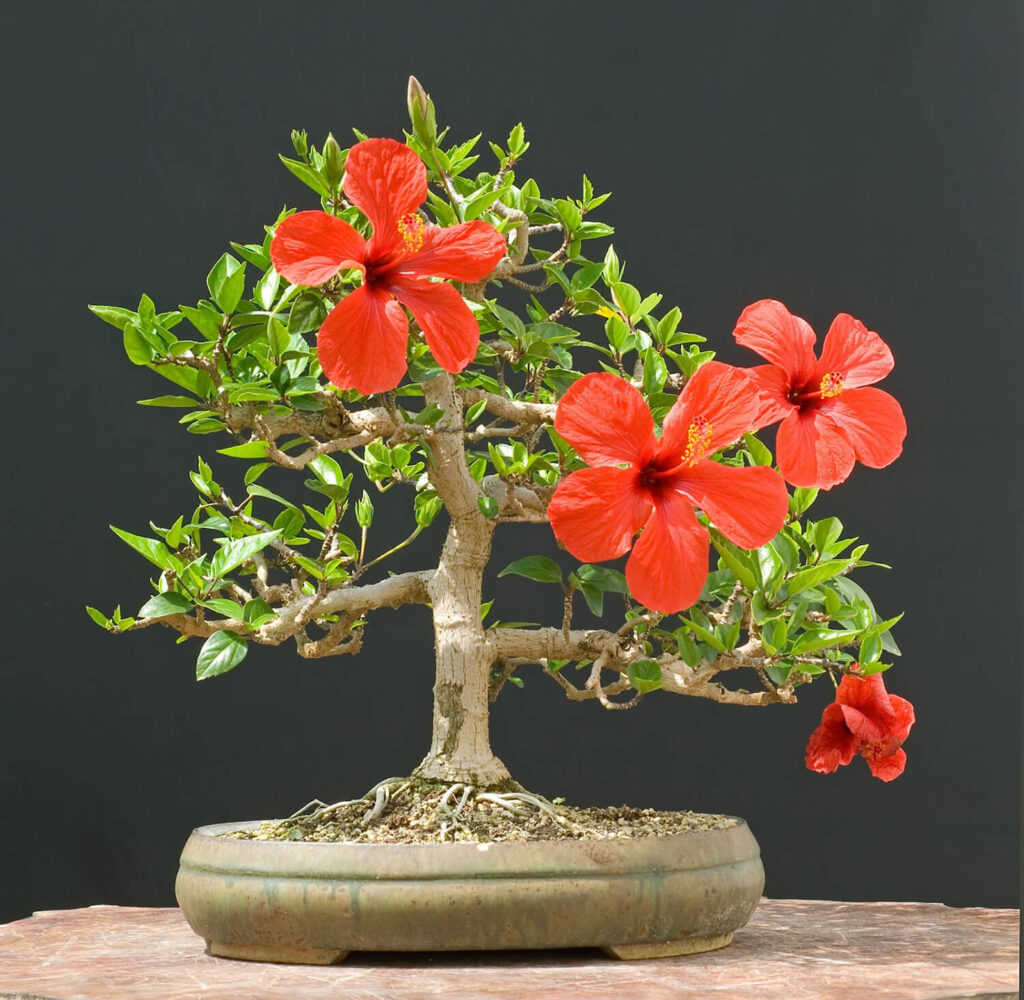
| Botanical name: | Hibiscus |
| Tree type: | Broadleaf tropical evergreen and temperate deciduous |
| Native habitat: | Tropical regions around the globe |
| Placement: | Both indoors and outdoors |
| Species to get: | Chinese hibiscus or China rose (Hibiscus rosa-sinensis) and Rose of Sharon (Hibiscus syriacus) |
| Cost range: | $25 to $496 |
Hibiscus is a species that has huge orange or bright red flowers.
The thing about these trumpet-shaped blossoms is that they can show up year-round. That means you’ll have an eye-striking bonsai if you grow one, regardless of the season. However, these flowers usually only last for one to three days.
Also, depending on the species, hibiscus can have glossy or matte-surfaced, toothed green leaves.
Choose the Chinese hibiscus species if you want to grow a large bonsai. On the other hand, grow a rose of sharon specimen to achieve a shohin size bonsai.
Pros:
- Hardy
- Produces good ramification
- Responds to pruning very well
- Non-susceptible to pests and diseases
Cons:
- Doesn’t like calcareous water
- Branches tend to break easily
14. Citrus
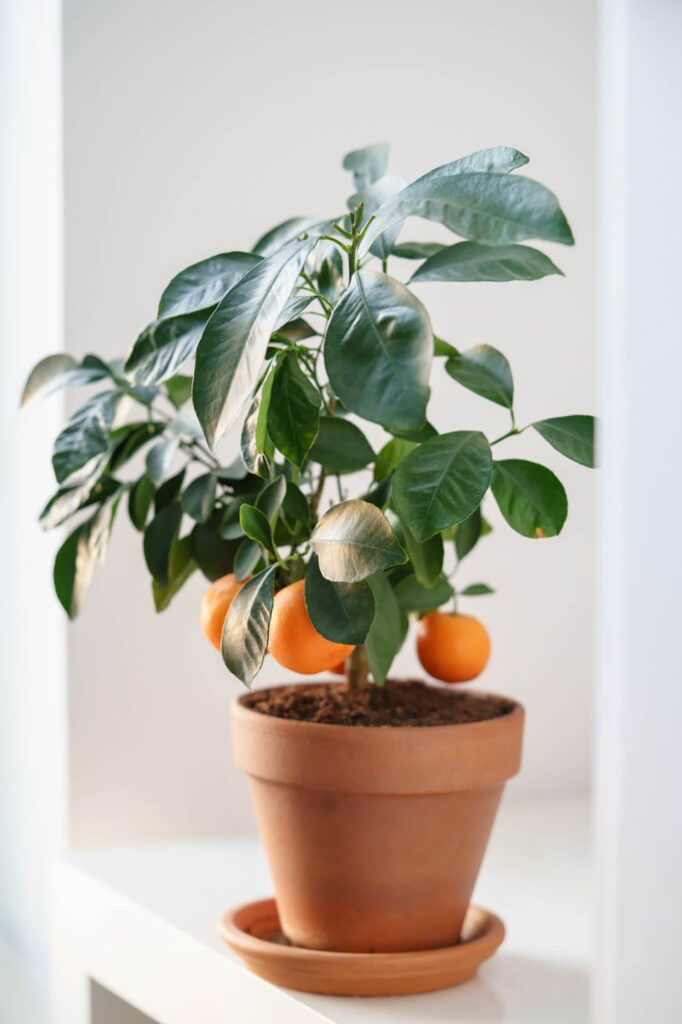
| Botanical name: | Citrus |
| Tree type: | Broadleaf evergreen |
| Native habitat: | China |
| Placement: | Both indoors and outdoors |
| Species to get: | Orange tree (Citrus sinensis) and Lemon tree (Citrus limon) |
| Cost range: | $90 to $125 |
Citrus bonsai is your best choice if you’re an orange or lemon fruit fan.
This subtropical tree can also bear fruits despite being planted in a bonsai pot, so you can devour your favorite citrus fruits straight from your home garden.
These fruits have a sweet fragrance and bright yellow or orange colors, which adds interest to the tree.
Additionally, most mature trees have dark green, shiny leaves and thick trunks.
Pros:
- Produces citrus fruits
- Tolerates temporary drought
Cons:
- Thorny (select species)
- Needs winter protection
- Requires regular pruning
- Doesn’t tolerate constant wet soil
- Very susceptible to pests and diseases
Key Takeaways:
Whether you’re just starting out or looking to deepen your bonsai skills with more challenging species, this article has explored a broad spectrum of evergreen bonsai trees suited to both beginners and intermediate growers. Here’s a consolidated look at our findings:
- Best Choices for Beginners:
- Juniper: With its low maintenance and easy shaping, Juniper tops the list as the ideal beginner-friendly evergreen bonsai. It thrives outdoors and offers aesthetic appeal with its slender trunk and fine needle pads.
- Ficus: Perfect for indoor environments, Ficus is hardy, pest-resistant, and can withstand low humidity, making it a forgiving choice for novices.
- Azalea: Known for its robustness and stunning blossoms, Azalea is excellent for beginners interested in flowering bonsais.
- Tamarind: Aside from its culinary uses, Tamarind is sturdy, tolerates heavy pruning, and adapts well to various climates, making it a practical choice for beginners.
- Ideal Species for Intermediate Growers:
- Japanese Black and Red Pine: These species are celebrated for their robustness and distinctive aesthetic, ideal for growers ready to handle a bit more challenge.
- Hinoki Cypress: Requiring more attentive care, this species rewards with its beautiful, scale-like foliage and textured bark.
- Brush Cherry: Known for its resilience to cooler temperatures and its ability to produce edible fruits, this tree is a step up for those looking to expand their bonsai repertoire.
- Growth and Maintenance Insights:
- Growth Considerations: While evergreen bonsai trees retain their leaves throughout the year, their growth rate and care requirements vary significantly across species.
- Maintenance Tips: Successful bonsai cultivation involves regular pruning, adequate light, and appropriate soil moisture. Understanding the specific needs of your bonsai species is crucial for maintaining its health and aesthetics.
- Decorative and Practical Benefits:
- Aesthetic Appeal: Each bonsai species brings its unique beauty, from the dramatic foliage of the Firethorn with its bright berries to the elegant flowers of the Azalea.
- Functional Uses: Some species like Tamarind offer additional benefits such as edible fruits, which add a functional element to their ornamental value.
That’s it! I hope that this guide has helped kick off your journey.





0 Comments